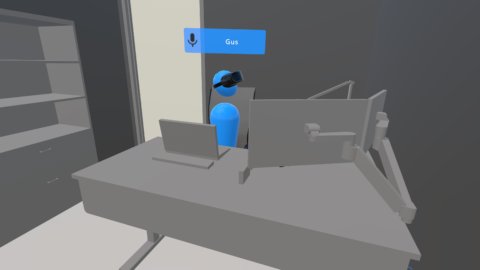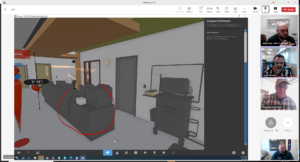
Reality capture is reshaping project planning by turning real-world sites into precise digital models. It helps teams, clients, and stakeholders to explore and refine projects collaboratively before construction begins.
RICK has been at the forefront of this innovation for over a decade with its Reality Portal, a tool that provides a fully navigable, digital version of a site.
Now, RICK is pushing this technology even further by integrating virtual reality (VR), giving clients the ability to walk through their projects in true-to-scale 3D environments.
“Clients don’t have to rely on blueprints or flat images anymore. They can put on a VR headset and step inside their project before the first foundation is poured.”— Josh Vandiver, Principal Reality Capture Project Manager
This technology is already making a major impact. It is currently being used on a million-square-foot VA hospital project in Kentucky, where RICK partnered with Strategic Medical Equipment Solutions, Inc. (SME) to help doctors and contractors refine the hospital layout in VR before construction even began.
What is Reality Capture?
Reality capture allows clients to interact with their projects remotely. Using high-detail laser scanning, RICK captures every aspect of a site and uploads it to an interactive platform where clients can pull dimensions and make critical design decisions.
VR takes this a step further by transforming these scans into fully immersive, true-to-scale models. Instead of viewing a site or building on a screen, clients can put on a headset and experience the space as if they were walking through it in real life.

This not only improves design accuracy but also cuts down on travel costs and allows open collaboration between clients, teams, and stakeholders, giving an up-to-date view of a project at any stage.
Partnering with Strategic Medical Equipment Solutions & the U.S. Department of Veteran’s Affairs
One of RICK’s biggest VR projects has been with Strategic Medical Equipment Solutions, Inc. (SME) and the U.S. Department of Veterans Affairs (VA). The collaboration began at a healthcare conference, where RICK’s VR demonstration caught the attention of an SME representative. They needed a way to integrate their hospital design models into VR and turned to RICK for help.
 The project—a million-square-foot VA hospital in Louisville, Kentucky—is massive. To ensure usability, RICK divided the model into 40 smaller, navigable VR areas so users could easily explore the space. With the help of VR, hospital staff could navigate their future workspace completely virtually.
The project—a million-square-foot VA hospital in Louisville, Kentucky—is massive. To ensure usability, RICK divided the model into 40 smaller, navigable VR areas so users could easily explore the space. With the help of VR, hospital staff could navigate their future workspace completely virtually.
Hospital staff and contractors were able to test room layouts, refine workspace configurations, and make adjustments before construction began. For example, head nurses could assess their office layouts and determine the best desk placement and size, while contractors could verify the sizing and positioning of medical equipment to ensure everything fits properly. This hands-on approach gave stakeholders confidence in their decisions before the hospital was even built.
“This was a high-profile project, and the VA called it ‘the Cadillac of VA hospitals.’ They wanted everything to be perfect, down to the smallest detail. Using VR ensured we could do just that.” — Josh Vandiver
The Impact of VR on Construction and Beyond
With VR, teams can fine-tune designs and collaborate on projects, all while working from the comfort of their own office. This technology has quickly become a staple across industries, with industry professionals and clients using it for everything from remote site visits to project evaluations. As this technology continues to advance, its impact on the way we plan, design, and manage projects will only grow.
“With the way VR hardware and software are evolving, we’re just scratching the surface. This is the future of project planning.” –—Josh Vandiver
The video below offers a closer look at how this technology is already transforming the way clients and teams experience and navigate their projects.